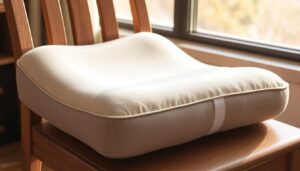Being a new parent means lots of sleepless nights and diaper changes. But, many forget about the back pain from holding a baby for hours. Golden State Orthopedics & Spine says this is a big problem for new parents. Ergonomic baby care is key to avoiding this pain. Using the right baby holding tips can help a lot. This article will show you how to hold a baby ergonomically. This way, you can take care of your baby without hurting your back.
Key Takeaways
- Understanding the risks of back pain associated with holding babies
- Learning proper ergonomic techniques for baby care
- Practical tips for holding your baby without straining your back
- The importance of posture in preventing back pain
- Simple adjustments to make a significant difference in your comfort
Understanding the Impact of Baby Holding on Parental Health
Holding and caring for a baby can hurt a parent’s back. The constant lifting and bending can strain muscles and joints. This can cause discomfort and pain.
Physical Demands of Infant Care
Caring for an infant is hard work. It includes feeding, changing diapers, and lifting the baby. These tasks need proper posture support to avoid back strain. Without it, new parents might feel tired and sore, making it hard to care for their baby.
Common Back Issues New Parents Face
New parents often get back pain from caring for their baby. This pain can be from lifting the baby wrong. Golden State Orthopedics & Spine says lifting is a big reason for back pain in new parents. Using the right techniques and support can help ease this pain.
| Common Back Issues | Causes | Prevention Techniques |
|---|---|---|
| Muscle Sprains | Lifting baby incorrectly | Proper lifting techniques, posture support |
| Strains | Overexertion, poor posture | Regular breaks, arm fatigue relief |
Long-term Health Implications of Poor Holding Techniques
Bad holding techniques can cause long-term back problems. These can include chronic pain and less mobility. It’s key for new parents to learn and use the right holding and lifting ways. This helps protect their back and keeps them healthy in the long run.
The Biomechanics of Back Pain in New Parents
Lifting and holding a baby can hurt a new parent’s back. Parents often bend in ways that strain their back. This can cause pain and might lead to long-term problems.
How Improper Lifting Affects Your Spine
Bad lifting, like bending from the waist, can hurt your spine. Golden State Orthopedics & Spine says to bend your knees when picking up your baby. This helps avoid back strain.
| Lifting Technique | Impact on Spine |
|---|---|
| Bending from the waist | High stress on lumbar spine |
| Squatting with bent knees | Reduced stress, more evenly distributed |
Muscle Groups Most Vulnerable to Strain
The muscles in your lower back and those for lifting are most at risk. Working these muscles with exercises can lower the chance of strain.
The Connection Between Posture and Pain
Good posture is key to avoiding back pain. Holding your baby close and not leaning forward helps your back.
Knowing how to care for a newborn without hurting your back is important. It keeps you healthy and lets you take better care of your baby.
Essential Preparation Before Lifting Your Baby
Getting ready to lift your baby is key for good posture and less arm tiredness. You need to set up a space that’s easy to move around in. Also, stand right and think about your body’s position.
Creating an Ergonomic Environment
Having a clean and open space is important. It helps you avoid straining your body. Golden State Orthopedics & Spine says good posture is crucial. It stops your muscles from getting too tight.

Proper Foot Positioning and Stance
Standing right is very important. Place your feet apart to keep your balance. This way, you can lift your baby safely and avoid hurting your back.
Mental Preparation and Body Awareness
Being aware of your body and planning your lift is key. Take a deep breath and lift with your legs. This keeps your back straight and your arms from getting tired.
| Preparation Step | Benefit |
|---|---|
| Creating an Ergonomic Environment | Reduces clutter and strain |
| Proper Foot Positioning and Stance | Distributes weight evenly, supports back |
| Mental Preparation and Body Awareness | Reduces risk of injury, promotes safe lifting |
By getting ready in these ways, you can lift your baby safely. Remember, being prepared is the best way to handle your baby without hurting yourself.
“When you stoop or slouch, your muscles strain to keep you balanced.” – Golden State Orthopedics & Spine
How to Hold a Baby Ergonomically: Core Principles
Understanding how to hold your baby is key to ergonomic baby care. It helps avoid back pain and keeps both you and your baby comfortable. There are a few main principles to follow.
Keeping the Baby Close to Your Center of Gravity
One main rule is to hold your baby near your body’s center. This makes it easier on your back. Holding them close to your chest or shoulder spreads out their weight.
Distributing Weight Evenly Across Your Body
It’s important to spread out the baby’s weight. You can do this by using both arms or one arm for support. This way, you don’t put all the weight on one side.
Maintaining Neutral Spine Alignment
Keeping your spine straight is crucial. Avoid bending or twisting, as it strains your back. Stay straight and use your core to keep your back in line.
Switching Positions Regularly to Prevent Fatigue
Changing how you hold your baby often is key. Holding them in one spot for too long can hurt your back. Switching or taking breaks helps avoid this.
| Holding Technique | Benefits | Precautions |
|---|---|---|
| Cradle Hold | Close contact, easy feeding | Avoid bending forward |
| Football Hold | Reduces strain on back and shoulders | Ensure baby’s head is supported |
| Shoulder Hold | Helps with burping, good for back | Be mindful of baby’s neck |
By following these main principles, you can lower the chance of back pain from holding your baby. It’s about finding a safe and comfy way to hold your baby.
The Cradle Hold: Classic Technique with Proper Support
Properly cradling a baby is more than just holding them close. It’s about using a technique that supports both the baby and the caregiver’s back. This classic hold is comfortable and secure for the baby. It also helps prevent strain on the parent’s body.
Step-by-Step Instructions for Back-Friendly Cradling
To cradle a baby right, start by sitting up straight. Use pillows or a supportive chair if you need to. Hold your baby close to your body, with their head near your breast.
Bring your baby to your breast instead of bending over to them. Use pillows to prop up the baby if needed. Experts like those at Golden State Orthopedics & Spine suggest this.
Make sure your arm is supported. You can use a pillow under your elbow or rest it on your body. This spreads out the baby’s weight and prevents arm fatigue.
Common Mistakes and How to Correct Them
A common mistake is leaning forward to cradle the baby. This strains the back. To fix this, adjust your position so the baby is brought to you while keeping your back straight.
Another mistake is not supporting the arm properly, leading to fatigue. Use a pillow or adjust your position to rest your arm. This helps avoid arm fatigue.
| Common Mistakes | Corrections |
|---|---|
| Leaning forward to cradle the baby | Bring the baby to you, maintaining a straight back |
| Not supporting the arm | Use a pillow or adjust your position to rest your arm |
When This Position Works Best
The cradle hold is great for feeding and bonding. It works best when both the parent and baby are comfortable. This makes the experience relaxed and enjoyable.
By following these tips, parents can enjoy the cradle hold. This helps protect their back while bonding with their baby.
The Football Hold: Relieving Shoulder and Arm Strain
Holding your baby like a football is safe and comfy. It helps your shoulders and arms feel better. This way, you don’t hurt your back or shoulders as much.

Proper Execution for Maximum Comfort
To hold your baby right, start with them on their back on a firm spot. Put one hand under their shoulders and head. This supports their neck.
Use your other hand to hold their bottom. Hold your baby tight, like a football. This keeps them safe and supported.
Key aspects to focus on are keeping your back straight and holding your baby close. This spreads out the weight and eases shoulder and back pain.
Benefits for C-Section Recovery
The football hold is great for moms after a C-section. It lets them hold their baby without hurting their tummy. This is important when they’re just starting to heal.
This method is good for both mom and baby. It helps them bond and can make breastfeeding easier.
Modifications for Growing Babies
As your baby gets bigger, you’ll need to change how you hold them. For bigger babies, use both arms. One arm goes under their shoulders, the other under their bottom.
Or, you can try a hip or shoulder carry. This is comfy for you and your baby as they grow. By adjusting your hold, you keep both of you happy and safe.
Upright Holds: Supporting Your Baby While Protecting Your Back
Upright holds are key in baby care. They help support your baby and protect your back. These holds keep you straight, reducing back strain from bending.
Shoulder Hold Techniques
The shoulder hold is a favorite. It lets you hold your baby on your shoulder. Hold the baby with one hand under their bottom and the other on their back.
This way, the baby’s weight is spread out. It helps your back and shoulders feel better.
Hip Carry Methods
Hip carry methods hold the baby on your hip. Stand with your feet apart and use one hand to hold the baby’s bottom. Keep your back straight.
This method uses your hips and legs. It helps avoid arm fatigue.
Front-Facing Positions That Minimize Strain
Front-facing positions are fun for interacting with your baby. But, keep your back straight to avoid strain. Use your core to support the baby.
Consider a front pack carrier for walking. It spreads the baby’s weight, easing arm fatigue and improving posture.
Using upright holds daily is good for you and your baby. Switch positions often to stay comfortable.
Feeding Positions That Won’t Compromise Your Spine
How you feed your baby affects your back health. It’s key to use ergonomic feeding methods. This helps avoid back pain and damage.
Breastfeeding Ergonomics
When you breastfeed, pick a comfy seat with back support. Choose a chair that keeps your back straight. Golden State Orthopedics & Spine says to bring the baby to you, not bend over.
Bottle Feeding Without Hunching
Bottle feeding needs good posture too. Use a pillow or cushion for back support. This keeps the baby at a good height, avoiding leaning forward.
Using Pillows and Supports Effectively
Pillows and supports are key for good feeding positions. They help support your back, arms, or the baby. This lets you feed without hurting your back. Try different setups to find what works for you and your baby.
Using these ergonomic feeding tips daily can lower back pain risks. It’s not just about the feeding position. Good posture and support are also important during these times.
Transferring Your Baby: From Arms to Crib Without Strain
Putting your baby down right is key for a healthy back. Moving your baby from your arms to their crib needs care to avoid back pain.
The Proper Lifting Sequence
To lift your baby safely, bend your knees and keep your back straight. This helps spread the weight, easing back strain. Golden State Orthopedics & Spine says bending your knees is key when picking up your baby.
Safe Lowering Techniques
When putting your baby in their crib, keep control and your baby close. This cuts down on arm tiredness. Slowly bend your knees, keep your back straight, and gently place your baby in the crib.
| Action | Benefit |
|---|---|
| Bend your knees when lifting | Reduces strain on your back |
| Keep your back straight | Maintains posture support |
| Lower yourself slowly | Prevents sudden strain |
Transitioning Between Different Surfaces
When moving your baby between places, like from your arms to a changing table or crib, do it smoothly. This keeps your back straight and reduces arm tiredness.

Baby-Wearing Solutions for Extended Carrying
Using a baby carrier can be a good way to carry your baby. But, picking the right one and using it right is key. Baby carriers are great, but they can hurt your back if not used right, says Golden State Orthopedics & Spine.
Choosing the Right Carrier for Your Body Type
It’s important to pick a baby carrier that fits your body. Think about your waist size, torso length, and what feels comfortable to you. There are many types of carriers, like wraps, slings, and structured ones. Each offers different support and adjustability.
Proper Adjustment and Weight Distribution
After picking a carrier, adjust it right to spread your baby’s weight evenly. Make sure it fits snug around your waist. Also, keep your baby close to you. This keeps your spine straight and eases back pain.
“A well-adjusted baby carrier can make a big difference in carrying your baby comfortably for a long time.”
Alternating Carrying Methods Throughout the Day
It’s smart to switch between carrying methods during the day. Try holding your baby, using a carrier, and putting them in a stroller. This spreads out the weight and lets your back rest.
| Carrying Method | Benefits | When to Use |
|---|---|---|
| Arms | Close bonding, easy feeding | During feeding, when at home |
| Baby Carrier | Hands-free, comfortable for long periods | When out and about, running errands |
| Stroller | Reduces back strain, good for long walks | During long walks, in crowded areas |
By picking the right baby carrier, adjusting it right, and switching carrying methods, you can enjoy baby-wearing safely and comfortably.
Strengthening Exercises for Parents’ Back Health
New parents should work on their core strength and flexibility. This helps avoid back pain when caring for a baby.
Core-Strengthening Routines
Exercises that strengthen the core are key for posture support and back pain prevention. You can do planks, bridges, and pelvic tilts at home.
- Plank: Hold for 30 seconds, rest for 30 seconds. Repeat 3-5 times.
- Bridge: Lie on your back with knees bent, lift your hips. Hold for 5 seconds, lower. Repeat 10-15 times.
- Pelvic Tilt: Lie on your back with knees bent, tilt your pelvis upwards. Hold for 5 seconds, release. Repeat 10-15 times.
Quick Stretches Between Baby Care
Adding quick stretches to your day can ease tension and boost flexibility. Try shoulder rolls, chest stretches, and hip flexor stretches when your baby sleeps or eats.
| Stretch | Description | Duration |
|---|---|---|
| Shoulder Rolls | Roll your shoulders forward and backward. | 10 repetitions |
| Chest Stretch | Stand in a doorway with arms up, lean forward. | 30 seconds per side |
| Hip Flexor Stretch | Kneel on one knee, push your hips forward. | 30 seconds per side |
Building Endurance for Extended Holding
It’s important to build endurance for arm fatigue relief and comfort while holding your baby. Try arm circles, wrist extensions, and shoulder blade squeezes.
- Arm Circles: Hold your arms straight out, make small circles. Repeat for 5 minutes.
- Wrist Extensions: Hold your arm out, lift your hand up. Repeat 10-15 times.
- Shoulder Blade Squeeze: Squeeze your shoulder blades together. Hold for 5 seconds, release. Repeat 10-15 times.
By doing these exercises daily, you can greatly improve your back health and lessen the strain of caring for your baby.
Recovery Techniques After Long Periods of Holding
Holding a baby can hurt your back a lot. It’s important to know how to feel better. New parents should talk to their doctor about safe exercises.
Effective Stretching Routines
Stretching often can help your muscles feel better. Stretch your back, shoulders, and arms. These areas get sore from holding a baby.
Try simple stretches like rolling your shoulders and opening your chest. Do these often during the day.
Heat and Cold Therapy Applications
Heat and cold can help with pain and swelling. A warm compress can relax muscles. Cold packs can reduce swelling.

Self-Massage Techniques for Tension Relief
Self-massage can ease tension, especially after holding a baby. Use soft, circular motions on your lower back and shoulders. This can help release tension.
For more help, use a foam roller or see a massage therapist.
Adding these recovery steps to your day can help you care for your baby without hurting your back. This makes caring for your baby healthier and easier.
Adaptive Strategies for Parents with Existing Back Problems
When you have back problems and become a parent, you need to learn new ways to hold your baby. It’s important to change how you hold your baby to avoid making your back worse. This helps you care for your baby without hurting your back.
Modified Holding Techniques for Specific Conditions
Every back problem is different. For example, if you have a herniated disc, you should avoid bending or twisting. Keeping the baby close to your body helps your back. The football hold is great because it keeps your back safe while holding your baby tight.
| Condition | Recommended Holding Technique | Benefit |
|---|---|---|
| Herniated Disc | Football Hold | Reduces bending and twisting |
| Lower Back Strain | Cradle Hold with Support | Distributes baby’s weight evenly |
| Post-C-Section | Upright Hold | Minimizes strain on abdominal muscles |
Working with Physical Therapists on Customized Approaches
A physical therapist can give you special advice on holding your baby safely. They can also help you make a plan to strengthen your back. If you had a C-section, wait until your doctor says it’s okay to start exercising again.
Assistive Devices and Their Proper Use
There are many tools that can help you hold your baby without straining your back. Baby carriers, for example, offer posture support and arm fatigue relief. Make sure the carrier fits well and follow the instructions for use.
Creating a Team Approach: Sharing the Physical Load
Working together in infant care can make things easier. Parents and caregivers can share the hard work. This way, no one gets too tired or hurt.
Communicating Needs with Partners and Caregivers
Talking openly is important for sharing baby care. Parents should share their needs and limits with others. This way, everyone knows their part and when to do it.
Establishing Rotation Systems for Infant Care
Using a rotation for tasks like feeding and changing helps. It stops people from getting too tired. It also lets everyone rest and have time for themselves.
When and How to Ask for Help
It’s okay to ask for help when needed. Parents should reach out to their support network. Having friends and family around can offer baby holding tips and help with ergonomic baby care.
By working together, parents can make caring for a baby easier and healthier for everyone.
Conclusion: Nurturing Your Baby While Protecting Your Body
Caring for a new baby is joyful but can be hard on your body. By using the right techniques, parents can avoid back pain. Keeping good posture is key to not straining your back.
Using the cradle hold, football hold, and upright holds helps spread out the baby’s weight. This makes caring for the baby easier and less tiring. Baby-wearing and exercises also help parents in their caregiving roles.
Being careful with your body and taking breaks is important. This way, parents can take care of their backs while enjoying their baby. With the right steps, parents can care for their baby and keep their body healthy.
FAQ
What are some ergonomic baby holding tips to prevent back pain?
Hold your baby close to your body. This helps keep your back straight. Switch how you hold your baby often.
How can I maintain proper posture while holding my baby?
Stand or sit straight. Don’t lean or slouch. Use your core to support your back.
What are some common mistakes to avoid when cradling a baby?
Don’t lean forward or twist your back. Make sure to support your arm and back well.
How can baby-wearing help with arm fatigue relief?
Baby-wearing spreads the baby’s weight over your body. This lets you move freely without holding the baby.
What are some exercises that can help strengthen my back and core for baby holding?
Do exercises that strengthen your core and back. This helps prevent back pain when holding your baby.
How can I recover from holding my baby for extended periods?
Stretch, use heat or cold, and massage yourself. This help ease tension and reduce muscle strain.
Are there any adaptive strategies for parents with existing back problems?
Yes, use special holding methods for your condition. Work with physical therapists. Use devices to ease back strain.
How can I create a team approach to caring for my baby and reduce the physical load?
Talk to your partner and caregivers about your needs. Share baby care duties. Know when to ask for help.
What are some tips for transferring my baby from my arms to a crib without straining my back?
Use the right lifting method. Lower your baby safely. Move them between surfaces carefully to avoid back strain.
Related Posts
- Pregnancy Posture Mistakes and How to Fix Them
- Best Office Chairs for Work-From-Home Moms
- Ergonomic Recliners for Pregnancy Support
- How to Avoid Wrist Pain While Bottle Feeding
- Top 5 Ergonomic Strollers for Active Moms
- Home
- Standing vs. Sitting for Baby Tasks: What’s Easier?
- Foam Rolling for Moms: How to Ease Tension at Home







